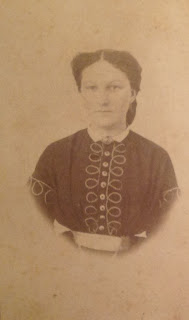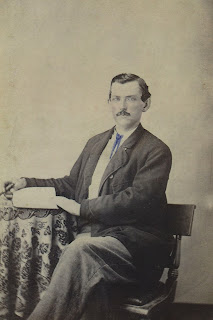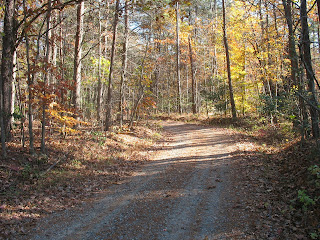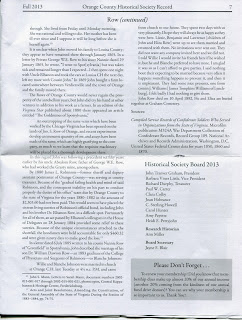 |
| Jonathan Taylor Mann |
A few years ago I became intrigued by the story of Jonathan Taylor Mann and had the good fortune to be able to contact his great great grandson, Jim Mann, who shared photographs and transcriptions of Mann family letters. Today's post is due largely to his research and his generosity and I am truly grateful to him. [Please note that all images can be clicked on for larger viewing]
Born June 21, 1821 in Danbury, New Hampshire, Jonathan T. Mann was the son of Scottish immigrants who arrived on our shores in 1811. By the mid 1840s Jonathan had begun traveling to Virginia, buying horses for resale in New Hampshire. It was likely during one of these trips that he met Sarah Joseph Spencer of Fluvanna County. He married her in 1849 and they had two sons together--James Joseph (born 1850) and Edgar Jonathan (born 1856).
 |
| Sarah and James Joseph Mann |
Jonathan's fourteen year old brother Dana joined him in 1851 and was a member of the household for the next nineteen years. Jonathan Mann worked as a farmer and as a repairer of watches and clocks, skills also acquired by Dana. The Manns were friends and neighbors of my Row ancestors in Orange County. In the map detail shown below, the Row(e) property is seen at the upper center of the image, on both sides of the Old Turnpike (modern Rt. 20) at Mine Run. The Mann property is located just southwest of there, near Grasty's gold mine.
 |
| Map detail of Orange County, 1863 |
During the turbulent years leading up to the Civil War, J.T. Mann became increasingly sympathetic to the political views of his adopted state. He became a slave owner, shown to be the owner of a ten year old girl in 1860. The raid of John Brown on Harper's Ferry in 1859 exercised a powerful effect on Jonathan, as it did on most southerners. He viewed the North-South conflict through the prism of his parents' experiences in the old world. The North and the federal government came to represent to Jonathan imperial England subjugating the rights of Scotsmen (i.e., southerners). His brother Dana came to share these opinions and both took up arms against the United States, which had been the source of refuge for their parents.
 |
| Captain John Sanders Row |
On April 1, 1862 J.T. Mann enlisted in Company I of the Sixth Virginia Cavalry. He was signed up by his friend Captain John Row, whose brother Dr. Elhanon Row and cousin (and my great grandfather) George Washington Estes Row also fought with the Sixth. At age forty one, Mann was old enough to be the father of many of his fellow troopers. His brother Dana joined the Second Virginia Artillery, which later became the Twenty Second Virginia Infantry Battalion.
About the time he enlisted Jonathan moved his wife and sons to her mother's home in Fluvanna for their safety. John Row also moved his family there for a time in order to escape the ever present threat of violence in Orange. Two of Captain Row's young sons died in Fluvanna in August 1862.
Mann and the Sixth Cavalry fought with Stonewall Jackson during the Valley Campaign. A letter he sent to Sarah on May 27, 1862 describes in cinematic detail the battle of Front Royal and its aftermath. The excerpt quoted here is one of the most dramatic depictions of a cavalry battle I have ever encountered in a private letter:
...After they were routed at Front Royal by the infantry and the artillery they ran up the turnpike about four or five miles and made a stand on a hill. Planted their cannon on the road, their infantry behind some houses and stone fences. Our cavalry were ordered to make a charge upon them. Our regiment which only had about 300 men in it then. The balance of them on picket, some dodging, some sick with crippled horses and about that time General Jackson rode up through the lines with his hat off at full speed or nearly so. Everyone gave him a cheer and our regiment rushed at full speed four miles to where the enemy had made a stand as before described and made a desperate charge. Ours was the fourth company from the front. We were ordered to their right in a field. They fired a volley at us as we charged up and then broke. We charged upon them at full speed about the time they broke, generally their balls went over our heads. Not a man in our company was hurt. The first in the charge were cut all to pieces. They had nine men killed and ten or twelve wounded. The captain of another company was killed. His name was Baxter [Captain George A. Baxter, Company K]. A braver man never lived. We took all the prisoners we took there and sent them off. Then charged up the turnpike towards Winchester eight miles as fast as we could get our horses along. We cut off all their wagons and took nearly all of them. A part or most of their cavalry got off. We took their artillery and arms...The pike was filled with wagons, horses, arms and munitions of war. For several miles knapsacks and everything that you could imagine belongs to war. Blankets and overcoats were strewed promiscuously in every direction. I galloped over dead bodies so covered in dirt that you could hardly tell that they were human. Dead horses scattered all along the road...The next morning we started again to attack their wagons that were said to be on their way from Strasburg to Winchester. We were formed in a line and our company were placed in advance and six of us, myself among the number, were detached as advance guard...We came in sight of new town saw down the pike towards Winchester a big smoke or dust from wagons. We halted until the regiment came up. Then we were ordered to charge upon them which we did as fast as the horses could go. Myself and three others put out. We got up to their infantry several hundred yards ahead of the others. The whole regiment charged with a tremendous yell. The enemy took fright and threw off their knapsacks and run for life.I rode up to a stone fence. There were seven blue coats hid behind the fence. I presented my pistol to them and ordered them over the fence. To my great relief they soon hopped over. I marched them back to headquarters and remained with them until the balance came up...
On August 8 Jonathan T. Mann was himself captured during the Cedar Mountain campaign. The records show that as of August 15 he was on a list of prisoners "confined by Major William E. Doster." (Doster fought with the 4th Pennsylvania Cavalry early in the war. Amazingly, he earned his law degree from Harvard University in 1863 and then became provost marshal of Washington, D.C. In 1865 Doster was appointed attorney for James Powell, one of the conspirators in the plot to murder Lincoln and Secretary of State Seward.) Mann was exchanged in September and rejoined his regiment.
J.T. Mann was promoted to Lieutenant in December 1862, most likely to replace James Roach, who had resigned in order to begin his term as sheriff of Orange County. That same month Jonathan wrote a letter to Sarah, in which me mentioned John Row's wife and father and sister: I saw Mrs. Rowe. They are well. Mrs [Reynolds], Col. Rowe's daughter, is very sick. They think she cannot live but a short time. After Elizabeth Keeling Row Reynolds died, her father Elhanon raised her children.
As a lieutenant, Jonathan T. Mann was now earning ninety dollars a month. Military life seemed to agree with him. He remained healthy and enjoyed the adventure of campaigning. In fact he gained weight and reported to his wife that he weighed 167 pounds. He wrote that his patrols were rounding up fifty Union deserters a day between Mount Jackson and Warrenton. These prisoners told him that their army was demoralized and that "they were tired of fighting for the negroes. May God send peace. No one would rejoice more than I would."
In his last letter to Sarah, dated May 23, 1863, Jonathan described a raid into Maryland and Pennsylvania to within eight miles of Ohio, "a journey of six or seven hundred miles." Seven hundred prisoners were taken, bridges were destroyed and other mischief accomplished. Most spectacular, however was the destruction of twenty five oil wells and barges loaded with oil on the Kanawha River.
Two weeks later Lieutenant Mann and the Sixth Cavalry were in Culpeper where they participated in the two grand cavalry reviews staged by General Jeb Stuart. They were resting from that endeavor on the morning of June 9 when troops commanded by General Alfred Pleasonton came splashing across the Rapidan, catching the Confederate cavalry completely by surprise. So much so, in fact, that troopers of the Sixth Cavalry had little or no time to prepare for battle, many jumping barefoot on their unsaddled mounts and then racing to the sound of gunfire. Clad only in his longjohns, Mann attacked Union forces threatening rebel artillery positions near Beverly's Ford. He was one of that morning's first casualties, shot in the face.
Not long after the battle of Brandy Station Sarah Mann came to the battlefield and found her husband's body. It was not possible to transport him to either Fluvanna or Orange, so she buried him on the farm of a friend at the foot of Clark's Mountain. In later years attempts were made by the Manns to locate his grave, but without success. J.T. Mann's name appears, together with those other Confederates who lost their lives during the war, on the memorial on the lawn of the Orange County Court House.
 | |
| Orange County Confederate memorial |
In the years following Mann's death John Row did what he could to help Sarah Mann and her boys. A number of letters written by John Row to Sarah were found in the archives of the Central Rappahannock Heritage Center and were quoted from in my piece on John Row. They give a good account of the stresses of life in Orange County during the war and its aftermath and are worth a click to here.
Sarah Mann and her sons returned to their home in Orange in late 1865. She described what she found in a letter to her mother dated December 27:
...it is torn to pieces but not as much as some of my neighbors' homes. What a destruction the soldiers of both armies made in this country. Things will never be replaced as before in my time or my children's. I fear we are bound to be poor people. No help for it the whole country is ruined...Several pieces of shell went through the dwelling house but not injuring it a great deal. Broke one of my bedsteads all to pieces, but my furniture was stolen by someone I do not know who.
Dana Mann came back to Orange and helped his sister in law get back on her feet. He finally returned to New Hampshire in 1870. Sarah Spencer Mann died on December 3, 1897 and is buried in the Rhoadesville Cemetery in Orange.
 |
| Sarah Spencer Mann |


























































































































